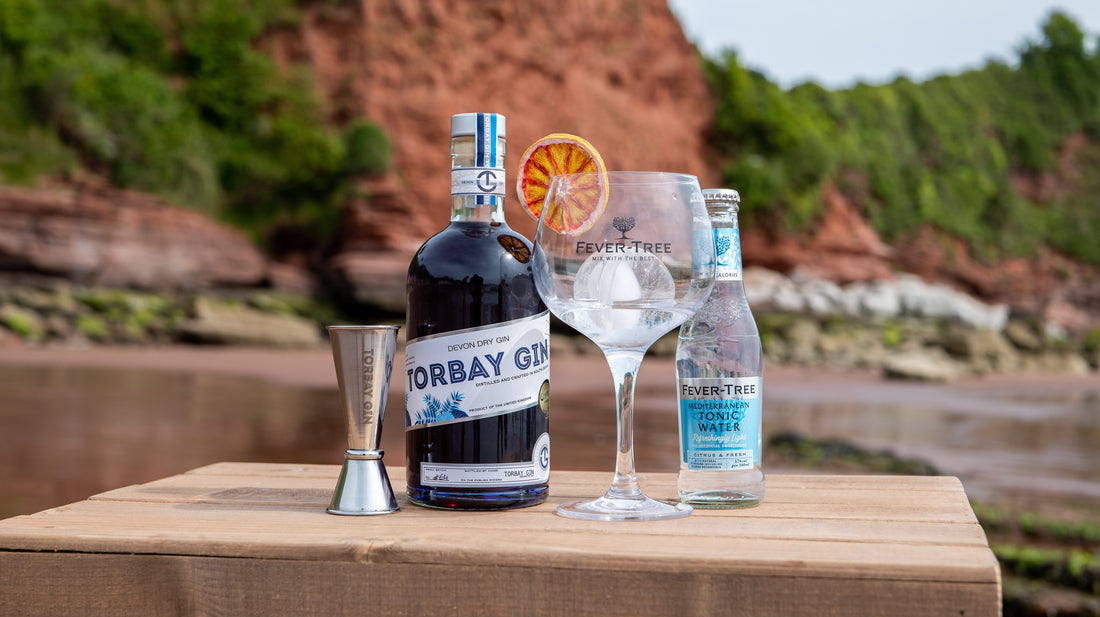A brilliant gin and tonic is simple: get the ratio right, match your tonic and garnish to the gin, keep everything ice-cold, and pour gently to protect the bubbles. We’ll cover the lot — from history and glassware to troubleshooting and calories. If three-quarters of your drink is the mixer, choosing the right tonic really matters.

The History of Gin and Tonic
Quinine, from cinchona bark, was used as an antimalarial long before modern tonic water; the first patent for “Tonic Water” is credited to Londoner Erasmus Bond (1858) (Country Life). The earliest printed call for a “gin and tonic” as a social drink appears in 1868 in the Oriental Sporting Magazine in British India (Kew Gardens). In the 2000s, Spain turbo-charged the modern gintonic culture with the copa de balón and chef-driven serves (Punch).
The Best Ratio of Gin to Tonic
Most credible specs sit between 1:2 and 1:3 (gin:tonic). Difford’s Guide lists ~45–60 ml gin to ~90–150 ml tonic (≈1:2); Fever-Tree’s house serve is 1:3.
Using 50 ml of 40% ABV gin:
- 1:1 (50 ml tonic; 100 ml total): ~20% ABV in-glass — spirit-forward.
- 1:2 (100 ml tonic; 150 ml total): ~13.3% ABV — classic balance.
-
1:3 (150 ml tonic; 200 ml total): ~10% ABV — lighter, more spritzy.
(calculations shown for transparency; ABV in glass varies with melt and tonic strength)
Tonic water – styles & pairing
Indian tonic gives classic quinine bite; Mediterranean styles use less quinine and add herbal-citrus notes (e.g., rosemary, lemon thyme) for a softer, floral profile (Fever-Tree Mediterranean). “Refreshingly Light” tonics trim sugar and calories while aiming to retain flavour (Fever-Tree Light Indian).
Typical label calories (per 100 ml):
- Fever-Tree Premium Indian: ~30 kcal (126 kJ) (product page).
- Fever-Tree Refreshingly Light Indian: ~15 kcal (64 kJ) (FR product page).
- Schweppes Indian Tonic (UK): ~21 kcal (Sainsbury’s item page).
House pairings (Torbay):
- Torbay Devon Dry Gin → Mediterranean tonic + lime (herbal-citrus tonic flatters a classic dry profile).
- Aurantiaco → Plain/Indian tonic + orange and/or raspberries (a neutral quinine backbone lets the citrus-berry botanicals shine).
- Matobo → Plain or Light tonic + kaffir (makrut) lime leaf or lime wedge (use Light for a drier finish; calorie-aware option).
What Gin To Use for a Gin and Tonic
Legal baseline (UK/EU): gin is a juniper-flavoured spirit with predominant juniper at ≥ 37.5% ABV (Legislation.gov.uk – EU 2019/787 as retained in GB). “London Dry” is a production style (not a place) with strict rules on flavourings and minimal sweetening; it’s prized for a crisp, juniper-citrus profile that holds up to tonic (see category definitions via WIPO summary).
Style pointers you can use:
- London Dry = the classic G&T backbone (juniper/citrus/coriander seed).
- Contemporary/floral gins often sing at 1:3 with a softer tonic (e.g., Mediterranean) (Fever-Tree Mediterranean).
- Navy-strength (~57% ABV) stands up to dilution but drinks punchier — measure carefully (bartender commentary via Epicurious).

Torbay Devon Dry Gin uses a traditional London Dry method, so choose this for a crisp classic.
Aurantiaco won Gold in the contemporary category at the Gin Guide Awards 2023. Choose this for a bright, fruit-led serve.
Matobo is great when you fancy an aromatic, spiced profile.
What Glass Should You Use?
Two excellent options:
Highball/Collins
Tall and narrow; preserves fizz and drinks ultra-refreshing (standard spec in many recipes) (Difford’s).
Copa de balón
Spain’s gintonic staple; generous bowl for lots of ice and aroma (Punch).
Pick the highball for crispness and CO₂ retention; pick the copa when aroma and presentation matter (and you’re using plenty of ice).
Should You Pour Gin or Tonic First?
Best practice to protect bubbles: ice → chilled gin → gently add chilled tonic down the inside of the glass (or over a barspoon), then one soft lift — no vigorous stirring (Punch highball technique; also see Difford’s method and Epicurious).
What To Garnish a Gin and Tonic With
Keep it purposeful and minimal, matching garnish to the gin’s botanicals — a principle echoed by the London Gin Club via Sipsmith: dry gins love lime/rhubarb/olive; floral gins like grapefruit/cucumber/rose; savoury profiles take rosemary/thyme/basil.
Spanish “gin-salads” can look fun, but excessive garnish can warm and muddle the drink.
Gin and Tonic - The Ultimate Recipe
- Fill a chilled glass to the with fresh, solid ice. More ice means less dilution.
- Add 50 ml of your choice of gin.
- Top with 100–150 ml chilled premium tonic for 1:2 to 1:3 ratio.
- Gently add tonic down the side; give one soft lift with a barspoon.
- Garnish as per the pairing above.

Is a Gin and Tonic Low Calorie?
“Low-calorie” is relative, but G&Ts can be moderate — especially with light tonic.
- Alcohol itself supplies ~7 kcal per gram (NHS).
- Drinkaware: a double G&T (50 ml) is ~153 kcal; double with diet/slimline ~112 kcal (Drinkaware).
- Tonic comparison (per 100 ml): Fever-Tree Premium Indian ~30 kcal; Refreshingly Light ~15 kcal; Schweppes Indian ~21 kcal.
Worked examples (50 ml gin at 40% ABV):
- 1:2 (50 ml gin + 100 ml regular tonic): ~118–132 kcal (brand-dependent).
- 1:3 (50 ml gin + 150 ml regular tonic): ~139–158 kcal.
- Using Refreshingly Light tonic trims ~21–31 kcal at 150 ml vs regular.
(estimates from spirit kcal + label tonic values above)
Troubleshooting Common Issues
“Too bitter.”
Switch to a Mediterranean tonic (less quinine) or lengthen to 1:3; try a lighter peel garnish instead of a full wedge.
“Too sweet.”
Use Refreshingly Light tonic and/or shorten to 1:2; pick a drier London Dry profile.
“Goes flat quickly.” .
Ensure everything is cold, pour gently, and use small, freshly opened tonics.
“Flavours feel muddled.”
Reduce garnish to one purposeful element matched to the botanicals; avoid the over-garnished “gin-salad” trend.
How Does Our Devon Dry Gin Change Colour?
Our signature serves use butterfly pea flower (Clitoria ternatea), rich in anthocyanins that act as pH indicators. They appear blue/violet around neutral pH and shift pink-purple as acidity rises — which is why your drink changes colour when it meets tonic (citric acid) or citrus juice.
Tip: more citrus → more pink; protect the drink from strong light for better colour longevity (pH/photo-stability notes in sources above)
To Conclude
Keep it cold, keep it simple, and let the gin lead. Start with 50 ml gin to 100–150 ml tonic, pour gently over plenty of fresh ice, and choose one purposeful garnish that echoes the botanicals. From there, dial the serve to your taste: Torbay Devon Dry Gin with Mediterranean tonic and lime for crisp refreshment; Aurantiaco with plain tonic and orange and/or raspberries for bright citrus; Matobo with plain or light tonic and a kaffir (makrut) lime leaf or lime wedge for a drier, spiced finish. Stock the fridge with small bottles of chilled tonic and you’ll pour G&Ts at home that beat most bars. When you’re ready to put it into practice, explore our gins and tell us your favourite ratio — we love seeing how Torbay drinks its G&Ts.




